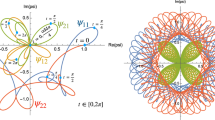Abstract
An introduction is first given of recent developments in the Riemannian geometry of quantum computation in which the quantum evolution is represented in the tangent space manifold of the special unitary unimodular group for n qubits. The Riemannian right-invariant metric, connection, curvature, geodesic equation for minimal complexity quantum circuits, Jacobi equation, and the lifted Jacobi equation for varying penalty parameter are reviewed. Sharpened tools for calculating the geodesic derivative are presented. The geodesic derivative may facilitate the numerical investigation of conjugate points and the global characteristics of geodesic paths in the group manifold, the determination of optimal quantum circuits for carrying out a quantum computation, and the determination of the complexity of particular quantum algorithms.
Similar content being viewed by others
References
Nielsen M.A., Chuang I.L.: Quantum Computation and Quantum Information. Cambridge University Press, Cambridge (2000)
Montgomery R.: A Tour of Sub-Riemannian Geometries, Their Geodesics and Applications, Vol. 91 of Mathematical Surveys and Monographs. American Mathematical Society, Providence (2002)
Khaneja N., Glaser S.J., Brockett R.: Sub-Riemannian geometry and time optimal control of three spin systems: quantum gates and coherence transfer. Phys. Rev. A 65(1–11), 032301 (2002)
Moseley C.G.: Geometric control of quantum spin systems. In: Donkor, E., Pirich, A.R., Brandt, H.E. (eds) Quantum Information and Computation II, Proceedings of the SPIE vol. 5436., pp. 319–323. SPIE, Bellingham (2004)
Nielsen M.A.: A geometric approach to quantum circuit lower bounds. Quantum Inf. Comput. 6, 213–262 (2006)
Nielsen M.A., Dowling M.R., Gu M., Doherty A.C.: Optimal control, geometry, and quantum computing. Phys. Rev. A 73(1–7), 062323 (2006)
Nielsen M.A., Dowling M.R., Gu M., Doherty A.C.: Quantum computation as geometry. Science 311, 1133–1135 (2006)
Dowling M.R., Nielsen M.A.: The geometry of quantum computation. Quantum Inf. Comput. 8, 0861–0899 (2008)
Clelland J.N., Moseley C.G.: Sub-Finsler geometry in dimension three. Differ. Geome. Appl. 24, 628–651 (2006)
Hou B.-Y., Hou B.-Y.: Differential Geometry for Physicists. World Scientific, Singapore (1997)
Sagle A.A., Walde R.E.: Introduction to Lie Groups and Lie Algebras. Academic Press, New York (1973)
Conlon L.: Differentiable Manifolds, 2nd edn. Birkhäuser, Boston (2001)
Lee J.M.: Riemannian Manifolds: An Introduction to Curvature. Springer, New York (1997)
Berger M.: A Panoramic View of Riemannian Geometry. Springer, Berlin (2003)
Milnor J.: Morse Theory. Princeton University Press, Princeton (1973)
Hall B.C.: Lie Groups, Lie Algebras, and Representations. Springer, New York (2004)
Farout J.: Analysis on Lie Groups. Cambridge University Press, Cambridge (2008)
Postnikov M.M.: Geometry VI: Riemannian Geometry, Encyclopedia of Mathematical Sciences, vol. 91. Springer, Berlin (2001)
Petersen P.: Riemannian Geometry, 2nd edn. Springer, New York (2006)
Jost J.: Riemannian Geometry and Geometric Analysis, 5th edn. Springer, Berlin (2008)
Wasserman R.: Tensors and Manifolds, 2nd edn. Oxford University Press, Oxford (2004)
Naimark M.A., Stern A.I.: Theory of Group Representations. Springer, New York (1982)
Sepanski M.R.: Compact Lie Groups. Springer, New York (2007)
Pfeifer W.: The Lie Algebras su(N). Birkhäuser, Basel (2003)
Stillwell J.: Naive Lie Theory. Springer, NY (2008)
Cornwell J.F.: Group Theory in Physics: An Introduction. Academic Press, San Diego (1997)
Cornwell J.F.: Group Theory in Physics, vols. 1 & 2. Academic Press, London (1984)
Steeb W., Hardy Y.: Problems and Solutions in Quantum Computing and Quantum Information, 2nd edn. World Scientific, New Jersey (2006)
Weigert S.: Baker-Campbell-Hausdorff relation for special unitary groups SU(N). J. Phys. A Math. Gen. 30, 8739–8749 (1997)
Reutenauer C.: Free Lie Algebras. Clarendon Press, Oxford (1993)
Dynkin E.: Calculation of the coefficients in the Campbell-Hausdorff formula. Dokl. Akad. Nauk 57, 323–326 (1947)
Baker, H.F.: Alternants and continuous groups. In: Proceedings of the London Mathematical Society, vol. 3, 2nd edn., pp. 24–47 (1905)
Campbell, J.E. On a law of combination of operators bearing on the theory of continuous transformation groups. In: Proceedings of the London Mathematical Society, vol. 28, 1st edn., pp. 381–390 (1897)
Campbell, J.E.: On a law of combination of operators. In: Proceedings of the London Mathematical Society, vol. 29, 1st edn., pp. 14–32 (1898)
Hausdorff F.: Die symbolische Exponentialformel in der Gruppentheorie. Leipziger Berichte 58, 19–48 (1906)
Misner, C.W., Thorne, K.S., Wheeler, J.A.: Gravitation, pp. 223, 224, 310. W. H. Freeman and Company, New York (1973)
Lax P.D.: Integrals of nonlinear equations of evolution and solitary waves. Commun. Pure Appl. Math. 21, 467–490 (1968)
Abraham R., Marsden J.E.: Foundations of Mechanics, 2nd edn. AMS Chelsea Publishing, American Mathematical Society, Providence (2008)
Zwillinger D.: Handbook of Differential Equations, 3rd edn. Academic Press, San Diego (1998)
Kaushal R.S., Parashar D.: Advanced Methods of Mathematical Physics. CRC Press, Boca Raton (2000)
Miwa T., Jimbo M., Date E.: Solitons. Cambridge University Press, Cambridge (2000)
Debnath L.: Nonlinear Partial Differential Equations. Birkhäuser, Boston (1997)
Zeidler E.: Nonlinear Functional Analysis and its Applications IV: Applications to Mathematical Physics. Springer, New York (1997)
Brandt, H.E.: Riemannian geometry of quantum computation. In: Lomonaco, S.J. (ed.) Proceedings of the Symposia Applied Mathematics, vol. 68, pp. 61–101 (2010)
Milnor J.: Curvatures of left invariant metrics on Lie groups. Adv. Math. 21, 293–329 (1976)
Arnold V.I.: Mathematical Methods of Classical Mechanics, 2nd edn. Springer, New York (1989)
Arnold V.I., Khesin B.A.: Topological Methods in Hydrodynamics. Springer, New York (1999)
Brandt H.E.: Riemannian curvature in the differential geometry of quantum computation. Phys. E 42, 449–453 (2010)
Brandt H.E.: Riemannian geometry of quantum computation. Nonlinear Anal. 71, e474–e485 (2009)
Milnor J.: Curvatures of left invariant metrics on Lie groups. Adv. Math. 21, 293–329 (1976)
Greiner W., Reinhardt J.: Field Quantization, vol. 219. Springer, Berlin (1996)
Weinberg S.: The Quantum Theory of Fields I, vol. 143. Cambridge University Press, Cambridge (1995)
Horn R., Johnson C.: Topics in Matrix Analysis, vol. 255. Cambridge University Press, Cambridge (1991)
Author information
Authors and Affiliations
Corresponding author
Rights and permissions
About this article
Cite this article
Brandt, H.E. Tools in the Riemannian geometry of quantum computation. Quantum Inf Process 11, 787–839 (2012). https://doi.org/10.1007/s11128-011-0290-6
Received:
Accepted:
Published:
Issue Date:
DOI: https://doi.org/10.1007/s11128-011-0290-6




